Analysis of Healthcare Economics at Cincinnati Children's Hospital
VerifiedAdded on 2021/04/17
|10
|2469
|34
Report
AI Summary
This report provides an in-depth analysis of the Cincinnati Children's Hospital Medical Center (CCHMC), examining its evolution from a pediatric examination center to a leading pediatric hospital. It explores CCHMC's strategic shifts, focusing on patient care, research, and education, and its financial growth. The report identifies challenges related to increasing demand, infrastructure, and human resource constraints. It details CCHMC's quality improvement initiatives, emphasizing the adoption of accreditation models and continuous improvement strategies. The analysis includes the business case for quality, the hospital's success in achieving its goals, and future concerns related to quality management and accreditation. The report also discusses the importance of adapting methodologies to meet the specific needs of the institution and the role of quality management in achieving and maintaining excellence in healthcare service delivery.

1
Health Care Economics
Name:
Course
Professor’s name
University name
City, State
Date of submission
Health Care Economics
Name:
Course
Professor’s name
University name
City, State
Date of submission
Paraphrase This Document
Need a fresh take? Get an instant paraphrase of this document with our AI Paraphraser
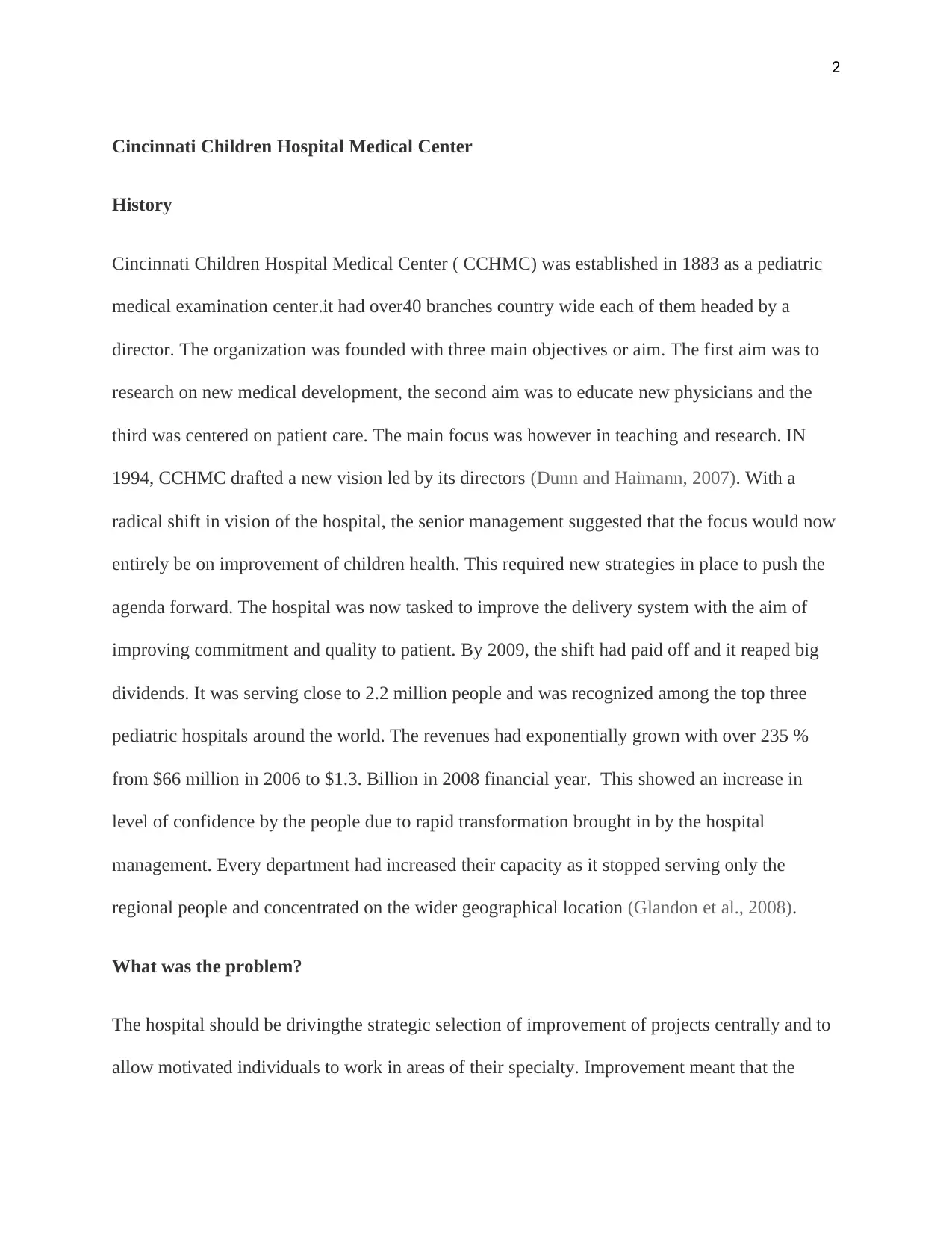
2
Cincinnati Children Hospital Medical Center
History
Cincinnati Children Hospital Medical Center ( CCHMC) was established in 1883 as a pediatric
medical examination center.it had over40 branches country wide each of them headed by a
director. The organization was founded with three main objectives or aim. The first aim was to
research on new medical development, the second aim was to educate new physicians and the
third was centered on patient care. The main focus was however in teaching and research. IN
1994, CCHMC drafted a new vision led by its directors (Dunn and Haimann, 2007). With a
radical shift in vision of the hospital, the senior management suggested that the focus would now
entirely be on improvement of children health. This required new strategies in place to push the
agenda forward. The hospital was now tasked to improve the delivery system with the aim of
improving commitment and quality to patient. By 2009, the shift had paid off and it reaped big
dividends. It was serving close to 2.2 million people and was recognized among the top three
pediatric hospitals around the world. The revenues had exponentially grown with over 235 %
from $66 million in 2006 to $1.3. Billion in 2008 financial year. This showed an increase in
level of confidence by the people due to rapid transformation brought in by the hospital
management. Every department had increased their capacity as it stopped serving only the
regional people and concentrated on the wider geographical location (Glandon et al., 2008).
What was the problem?
The hospital should be drivingthe strategic selection of improvement of projects centrally and to
allow motivated individuals to work in areas of their specialty. Improvement meant that the
Cincinnati Children Hospital Medical Center
History
Cincinnati Children Hospital Medical Center ( CCHMC) was established in 1883 as a pediatric
medical examination center.it had over40 branches country wide each of them headed by a
director. The organization was founded with three main objectives or aim. The first aim was to
research on new medical development, the second aim was to educate new physicians and the
third was centered on patient care. The main focus was however in teaching and research. IN
1994, CCHMC drafted a new vision led by its directors (Dunn and Haimann, 2007). With a
radical shift in vision of the hospital, the senior management suggested that the focus would now
entirely be on improvement of children health. This required new strategies in place to push the
agenda forward. The hospital was now tasked to improve the delivery system with the aim of
improving commitment and quality to patient. By 2009, the shift had paid off and it reaped big
dividends. It was serving close to 2.2 million people and was recognized among the top three
pediatric hospitals around the world. The revenues had exponentially grown with over 235 %
from $66 million in 2006 to $1.3. Billion in 2008 financial year. This showed an increase in
level of confidence by the people due to rapid transformation brought in by the hospital
management. Every department had increased their capacity as it stopped serving only the
regional people and concentrated on the wider geographical location (Glandon et al., 2008).
What was the problem?
The hospital should be drivingthe strategic selection of improvement of projects centrally and to
allow motivated individuals to work in areas of their specialty. Improvement meant that the
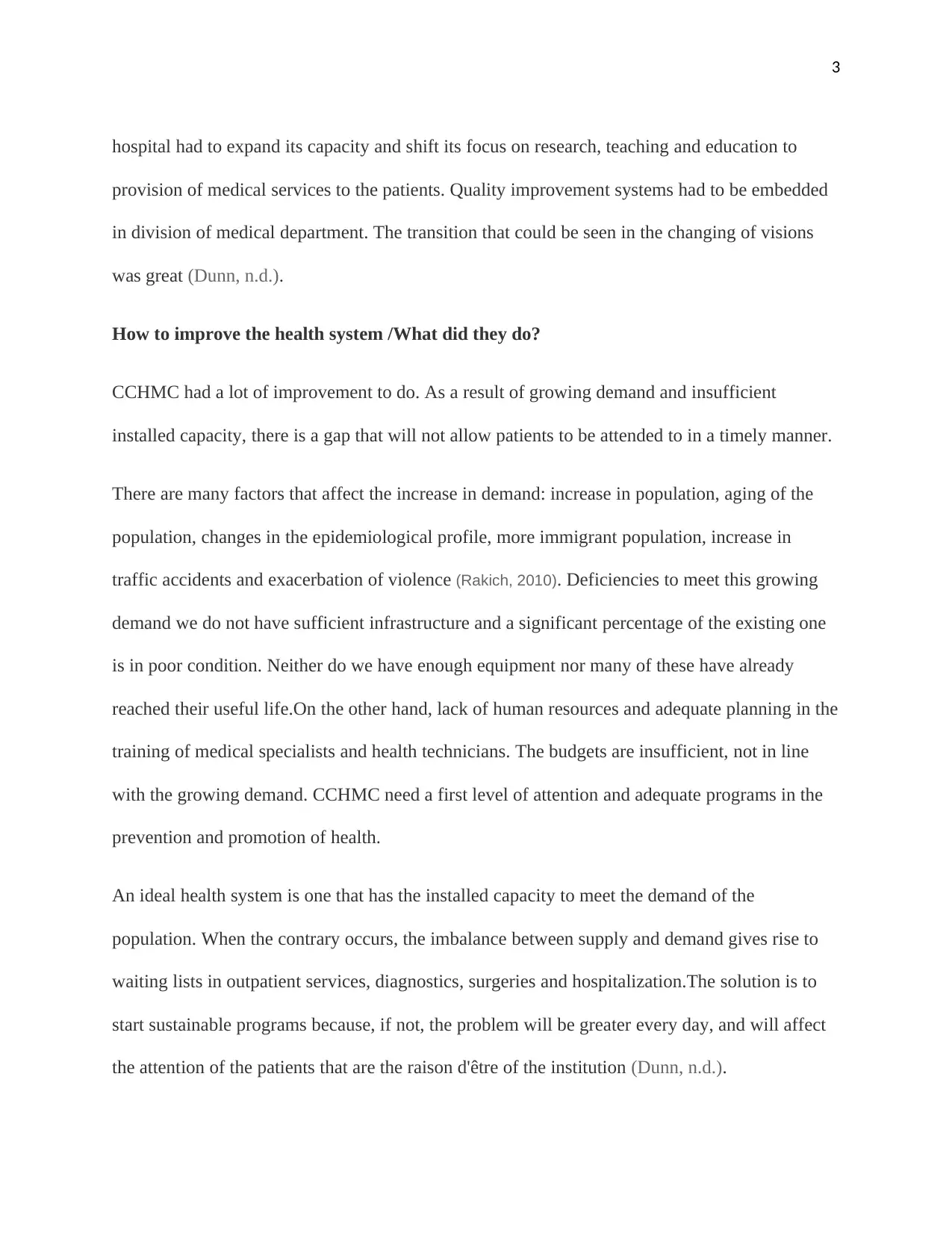
3
hospital had to expand its capacity and shift its focus on research, teaching and education to
provision of medical services to the patients. Quality improvement systems had to be embedded
in division of medical department. The transition that could be seen in the changing of visions
was great (Dunn, n.d.).
How to improve the health system /What did they do?
CCHMC had a lot of improvement to do. As a result of growing demand and insufficient
installed capacity, there is a gap that will not allow patients to be attended to in a timely manner.
There are many factors that affect the increase in demand: increase in population, aging of the
population, changes in the epidemiological profile, more immigrant population, increase in
traffic accidents and exacerbation of violence (Rakich, 2010). Deficiencies to meet this growing
demand we do not have sufficient infrastructure and a significant percentage of the existing one
is in poor condition. Neither do we have enough equipment nor many of these have already
reached their useful life.On the other hand, lack of human resources and adequate planning in the
training of medical specialists and health technicians. The budgets are insufficient, not in line
with the growing demand. CCHMC need a first level of attention and adequate programs in the
prevention and promotion of health.
An ideal health system is one that has the installed capacity to meet the demand of the
population. When the contrary occurs, the imbalance between supply and demand gives rise to
waiting lists in outpatient services, diagnostics, surgeries and hospitalization.The solution is to
start sustainable programs because, if not, the problem will be greater every day, and will affect
the attention of the patients that are the raison d'être of the institution (Dunn, n.d.).
hospital had to expand its capacity and shift its focus on research, teaching and education to
provision of medical services to the patients. Quality improvement systems had to be embedded
in division of medical department. The transition that could be seen in the changing of visions
was great (Dunn, n.d.).
How to improve the health system /What did they do?
CCHMC had a lot of improvement to do. As a result of growing demand and insufficient
installed capacity, there is a gap that will not allow patients to be attended to in a timely manner.
There are many factors that affect the increase in demand: increase in population, aging of the
population, changes in the epidemiological profile, more immigrant population, increase in
traffic accidents and exacerbation of violence (Rakich, 2010). Deficiencies to meet this growing
demand we do not have sufficient infrastructure and a significant percentage of the existing one
is in poor condition. Neither do we have enough equipment nor many of these have already
reached their useful life.On the other hand, lack of human resources and adequate planning in the
training of medical specialists and health technicians. The budgets are insufficient, not in line
with the growing demand. CCHMC need a first level of attention and adequate programs in the
prevention and promotion of health.
An ideal health system is one that has the installed capacity to meet the demand of the
population. When the contrary occurs, the imbalance between supply and demand gives rise to
waiting lists in outpatient services, diagnostics, surgeries and hospitalization.The solution is to
start sustainable programs because, if not, the problem will be greater every day, and will affect
the attention of the patients that are the raison d'être of the institution (Dunn, n.d.).
⊘ This is a preview!⊘
Do you want full access?
Subscribe today to unlock all pages.

Trusted by 1+ million students worldwide
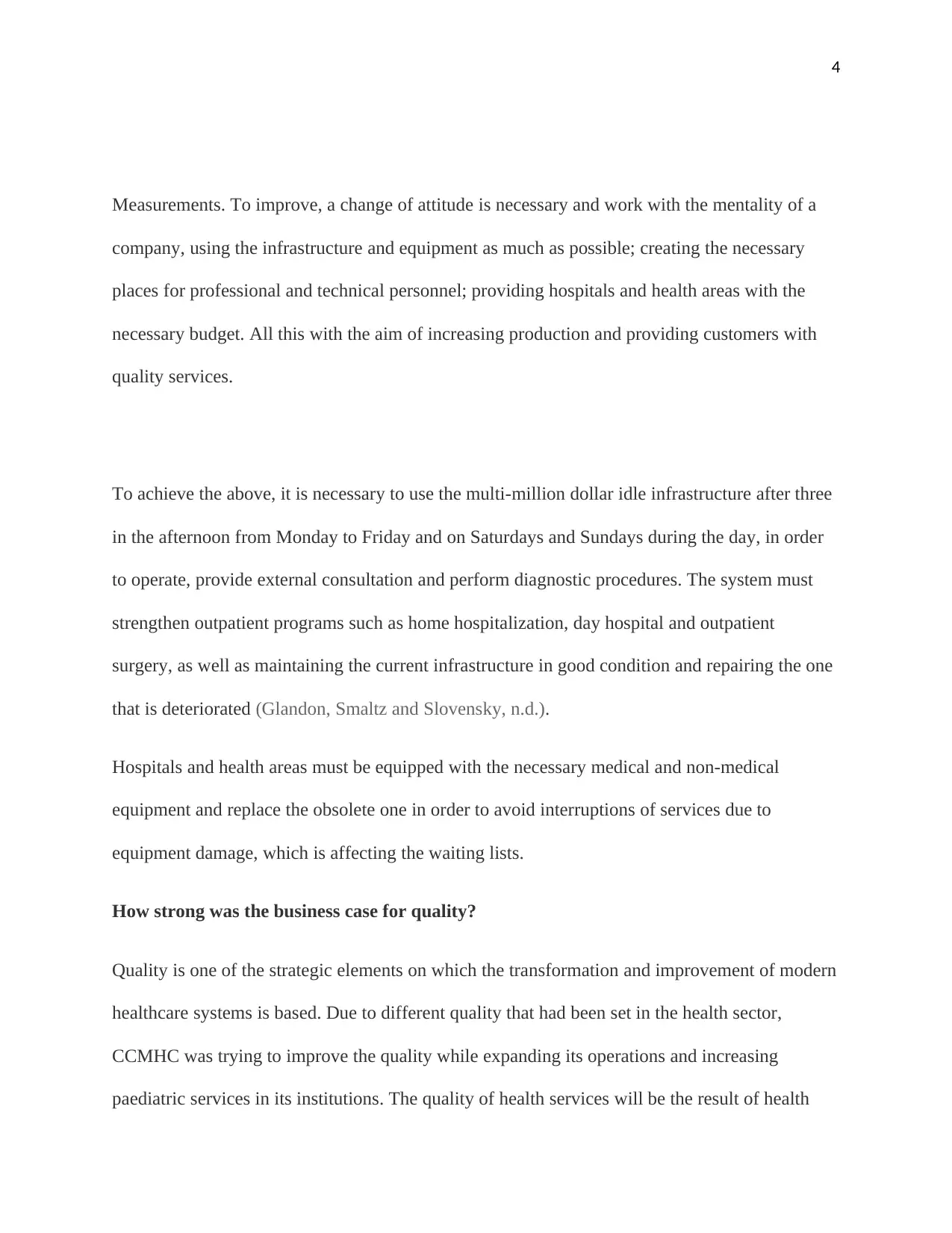
4
Measurements. To improve, a change of attitude is necessary and work with the mentality of a
company, using the infrastructure and equipment as much as possible; creating the necessary
places for professional and technical personnel; providing hospitals and health areas with the
necessary budget. All this with the aim of increasing production and providing customers with
quality services.
To achieve the above, it is necessary to use the multi-million dollar idle infrastructure after three
in the afternoon from Monday to Friday and on Saturdays and Sundays during the day, in order
to operate, provide external consultation and perform diagnostic procedures. The system must
strengthen outpatient programs such as home hospitalization, day hospital and outpatient
surgery, as well as maintaining the current infrastructure in good condition and repairing the one
that is deteriorated (Glandon, Smaltz and Slovensky, n.d.).
Hospitals and health areas must be equipped with the necessary medical and non-medical
equipment and replace the obsolete one in order to avoid interruptions of services due to
equipment damage, which is affecting the waiting lists.
How strong was the business case for quality?
Quality is one of the strategic elements on which the transformation and improvement of modern
healthcare systems is based. Due to different quality that had been set in the health sector,
CCMHC was trying to improve the quality while expanding its operations and increasing
paediatric services in its institutions. The quality of health services will be the result of health
Measurements. To improve, a change of attitude is necessary and work with the mentality of a
company, using the infrastructure and equipment as much as possible; creating the necessary
places for professional and technical personnel; providing hospitals and health areas with the
necessary budget. All this with the aim of increasing production and providing customers with
quality services.
To achieve the above, it is necessary to use the multi-million dollar idle infrastructure after three
in the afternoon from Monday to Friday and on Saturdays and Sundays during the day, in order
to operate, provide external consultation and perform diagnostic procedures. The system must
strengthen outpatient programs such as home hospitalization, day hospital and outpatient
surgery, as well as maintaining the current infrastructure in good condition and repairing the one
that is deteriorated (Glandon, Smaltz and Slovensky, n.d.).
Hospitals and health areas must be equipped with the necessary medical and non-medical
equipment and replace the obsolete one in order to avoid interruptions of services due to
equipment damage, which is affecting the waiting lists.
How strong was the business case for quality?
Quality is one of the strategic elements on which the transformation and improvement of modern
healthcare systems is based. Due to different quality that had been set in the health sector,
CCMHC was trying to improve the quality while expanding its operations and increasing
paediatric services in its institutions. The quality of health services will be the result of health
Paraphrase This Document
Need a fresh take? Get an instant paraphrase of this document with our AI Paraphraser
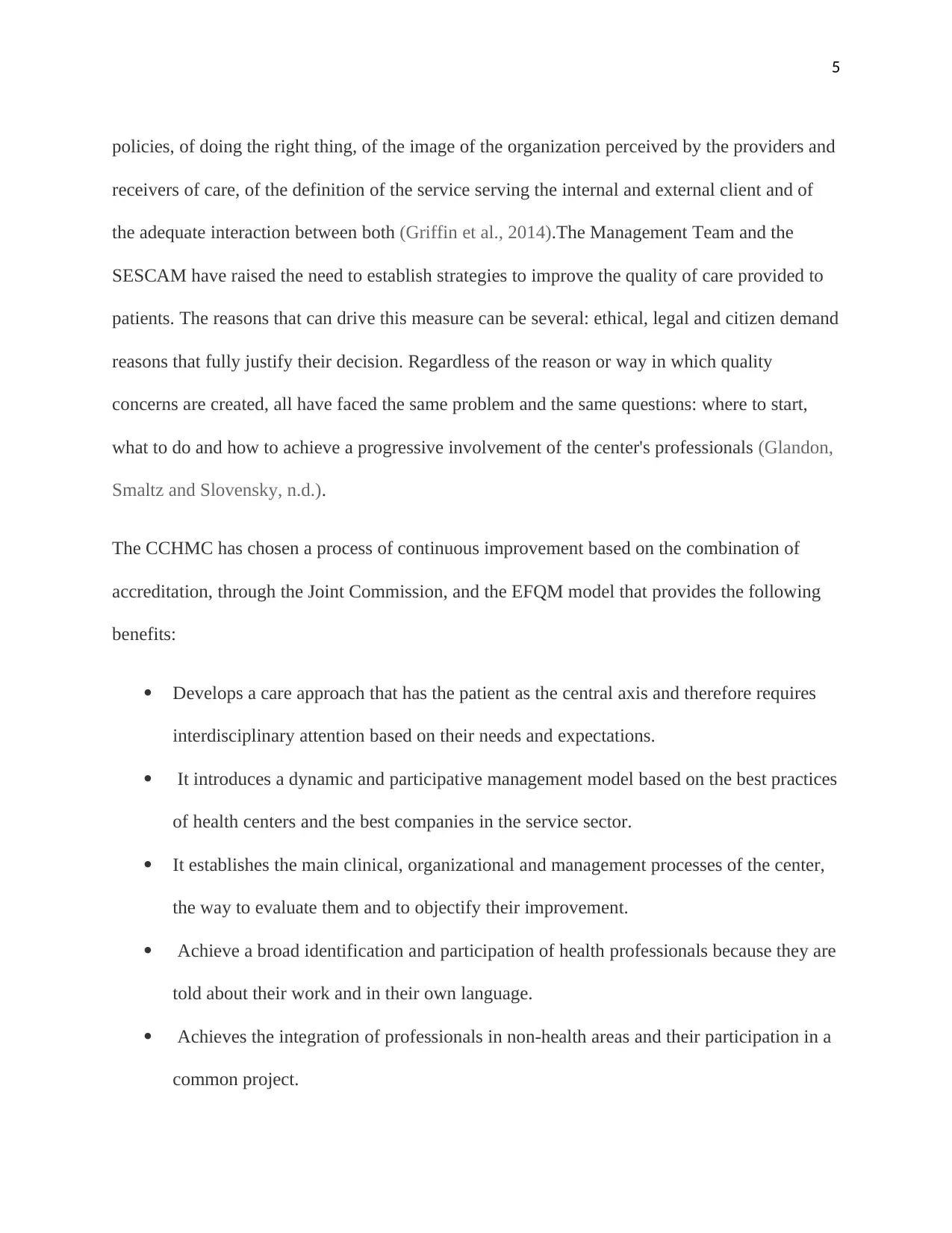
5
policies, of doing the right thing, of the image of the organization perceived by the providers and
receivers of care, of the definition of the service serving the internal and external client and of
the adequate interaction between both (Griffin et al., 2014).The Management Team and the
SESCAM have raised the need to establish strategies to improve the quality of care provided to
patients. The reasons that can drive this measure can be several: ethical, legal and citizen demand
reasons that fully justify their decision. Regardless of the reason or way in which quality
concerns are created, all have faced the same problem and the same questions: where to start,
what to do and how to achieve a progressive involvement of the center's professionals (Glandon,
Smaltz and Slovensky, n.d.).
The CCHMC has chosen a process of continuous improvement based on the combination of
accreditation, through the Joint Commission, and the EFQM model that provides the following
benefits:
Develops a care approach that has the patient as the central axis and therefore requires
interdisciplinary attention based on their needs and expectations.
It introduces a dynamic and participative management model based on the best practices
of health centers and the best companies in the service sector.
It establishes the main clinical, organizational and management processes of the center,
the way to evaluate them and to objectify their improvement.
Achieve a broad identification and participation of health professionals because they are
told about their work and in their own language.
Achieves the integration of professionals in non-health areas and their participation in a
common project.
policies, of doing the right thing, of the image of the organization perceived by the providers and
receivers of care, of the definition of the service serving the internal and external client and of
the adequate interaction between both (Griffin et al., 2014).The Management Team and the
SESCAM have raised the need to establish strategies to improve the quality of care provided to
patients. The reasons that can drive this measure can be several: ethical, legal and citizen demand
reasons that fully justify their decision. Regardless of the reason or way in which quality
concerns are created, all have faced the same problem and the same questions: where to start,
what to do and how to achieve a progressive involvement of the center's professionals (Glandon,
Smaltz and Slovensky, n.d.).
The CCHMC has chosen a process of continuous improvement based on the combination of
accreditation, through the Joint Commission, and the EFQM model that provides the following
benefits:
Develops a care approach that has the patient as the central axis and therefore requires
interdisciplinary attention based on their needs and expectations.
It introduces a dynamic and participative management model based on the best practices
of health centers and the best companies in the service sector.
It establishes the main clinical, organizational and management processes of the center,
the way to evaluate them and to objectify their improvement.
Achieve a broad identification and participation of health professionals because they are
told about their work and in their own language.
Achieves the integration of professionals in non-health areas and their participation in a
common project.
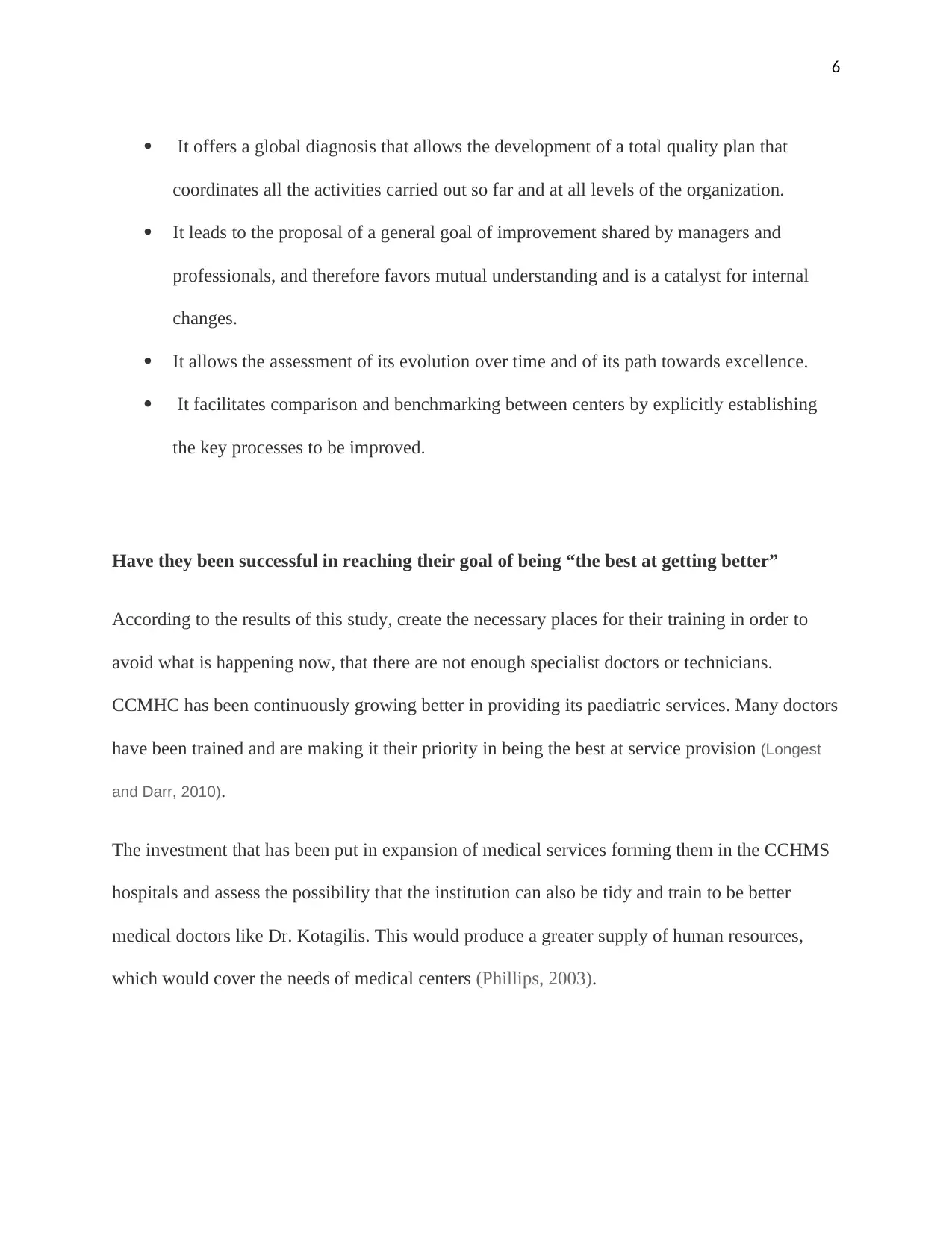
6
It offers a global diagnosis that allows the development of a total quality plan that
coordinates all the activities carried out so far and at all levels of the organization.
It leads to the proposal of a general goal of improvement shared by managers and
professionals, and therefore favors mutual understanding and is a catalyst for internal
changes.
It allows the assessment of its evolution over time and of its path towards excellence.
It facilitates comparison and benchmarking between centers by explicitly establishing
the key processes to be improved.
Have they been successful in reaching their goal of being “the best at getting better”
According to the results of this study, create the necessary places for their training in order to
avoid what is happening now, that there are not enough specialist doctors or technicians.
CCMHC has been continuously growing better in providing its paediatric services. Many doctors
have been trained and are making it their priority in being the best at service provision (Longest
and Darr, 2010).
The investment that has been put in expansion of medical services forming them in the CCHMS
hospitals and assess the possibility that the institution can also be tidy and train to be better
medical doctors like Dr. Kotagilis. This would produce a greater supply of human resources,
which would cover the needs of medical centers (Phillips, 2003).
It offers a global diagnosis that allows the development of a total quality plan that
coordinates all the activities carried out so far and at all levels of the organization.
It leads to the proposal of a general goal of improvement shared by managers and
professionals, and therefore favors mutual understanding and is a catalyst for internal
changes.
It allows the assessment of its evolution over time and of its path towards excellence.
It facilitates comparison and benchmarking between centers by explicitly establishing
the key processes to be improved.
Have they been successful in reaching their goal of being “the best at getting better”
According to the results of this study, create the necessary places for their training in order to
avoid what is happening now, that there are not enough specialist doctors or technicians.
CCMHC has been continuously growing better in providing its paediatric services. Many doctors
have been trained and are making it their priority in being the best at service provision (Longest
and Darr, 2010).
The investment that has been put in expansion of medical services forming them in the CCHMS
hospitals and assess the possibility that the institution can also be tidy and train to be better
medical doctors like Dr. Kotagilis. This would produce a greater supply of human resources,
which would cover the needs of medical centers (Phillips, 2003).
⊘ This is a preview!⊘
Do you want full access?
Subscribe today to unlock all pages.

Trusted by 1+ million students worldwide
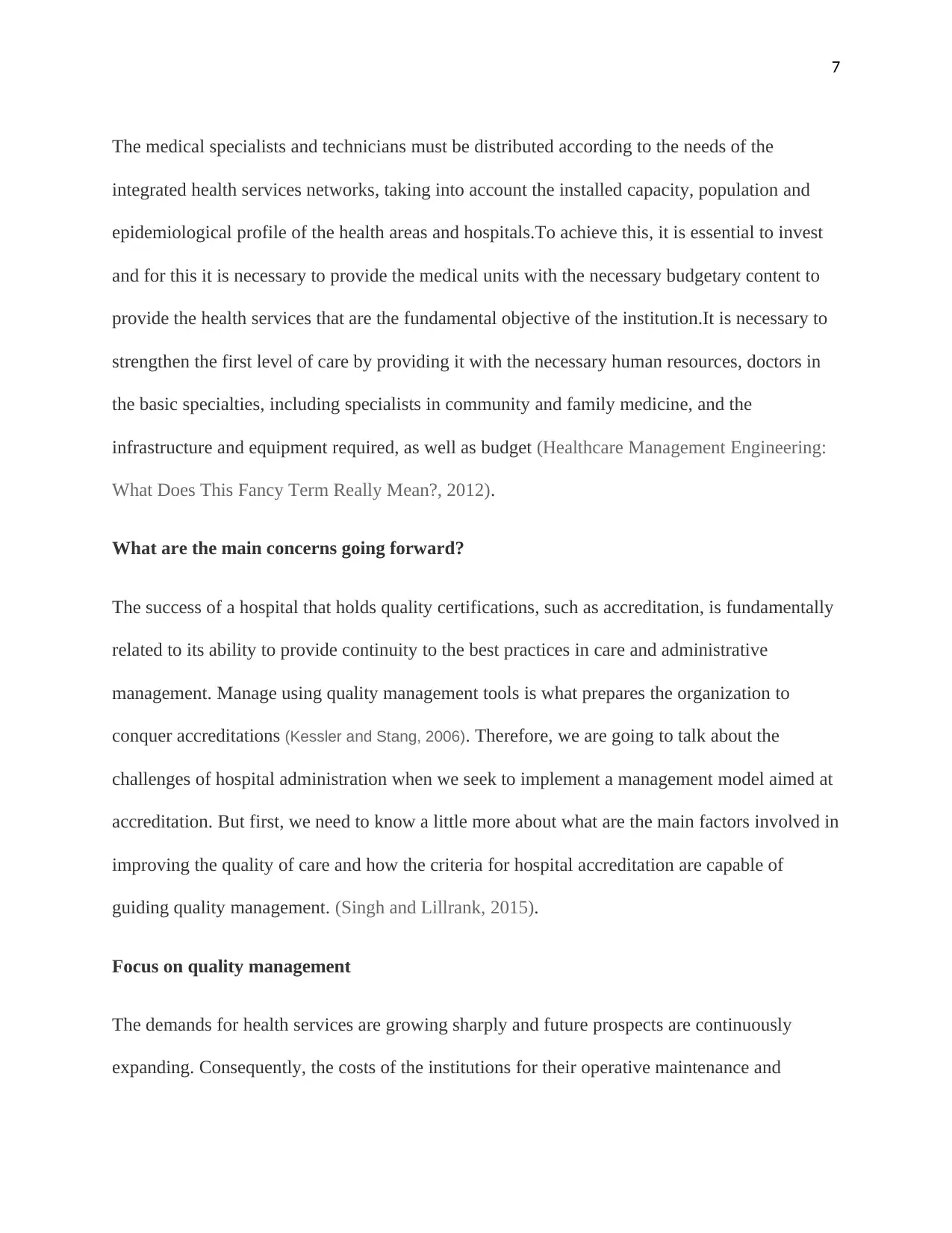
7
The medical specialists and technicians must be distributed according to the needs of the
integrated health services networks, taking into account the installed capacity, population and
epidemiological profile of the health areas and hospitals.To achieve this, it is essential to invest
and for this it is necessary to provide the medical units with the necessary budgetary content to
provide the health services that are the fundamental objective of the institution.It is necessary to
strengthen the first level of care by providing it with the necessary human resources, doctors in
the basic specialties, including specialists in community and family medicine, and the
infrastructure and equipment required, as well as budget (Healthcare Management Engineering:
What Does This Fancy Term Really Mean?, 2012).
What are the main concerns going forward?
The success of a hospital that holds quality certifications, such as accreditation, is fundamentally
related to its ability to provide continuity to the best practices in care and administrative
management. Manage using quality management tools is what prepares the organization to
conquer accreditations (Kessler and Stang, 2006). Therefore, we are going to talk about the
challenges of hospital administration when we seek to implement a management model aimed at
accreditation. But first, we need to know a little more about what are the main factors involved in
improving the quality of care and how the criteria for hospital accreditation are capable of
guiding quality management. (Singh and Lillrank, 2015).
Focus on quality management
The demands for health services are growing sharply and future prospects are continuously
expanding. Consequently, the costs of the institutions for their operative maintenance and
The medical specialists and technicians must be distributed according to the needs of the
integrated health services networks, taking into account the installed capacity, population and
epidemiological profile of the health areas and hospitals.To achieve this, it is essential to invest
and for this it is necessary to provide the medical units with the necessary budgetary content to
provide the health services that are the fundamental objective of the institution.It is necessary to
strengthen the first level of care by providing it with the necessary human resources, doctors in
the basic specialties, including specialists in community and family medicine, and the
infrastructure and equipment required, as well as budget (Healthcare Management Engineering:
What Does This Fancy Term Really Mean?, 2012).
What are the main concerns going forward?
The success of a hospital that holds quality certifications, such as accreditation, is fundamentally
related to its ability to provide continuity to the best practices in care and administrative
management. Manage using quality management tools is what prepares the organization to
conquer accreditations (Kessler and Stang, 2006). Therefore, we are going to talk about the
challenges of hospital administration when we seek to implement a management model aimed at
accreditation. But first, we need to know a little more about what are the main factors involved in
improving the quality of care and how the criteria for hospital accreditation are capable of
guiding quality management. (Singh and Lillrank, 2015).
Focus on quality management
The demands for health services are growing sharply and future prospects are continuously
expanding. Consequently, the costs of the institutions for their operative maintenance and
Paraphrase This Document
Need a fresh take? Get an instant paraphrase of this document with our AI Paraphraser
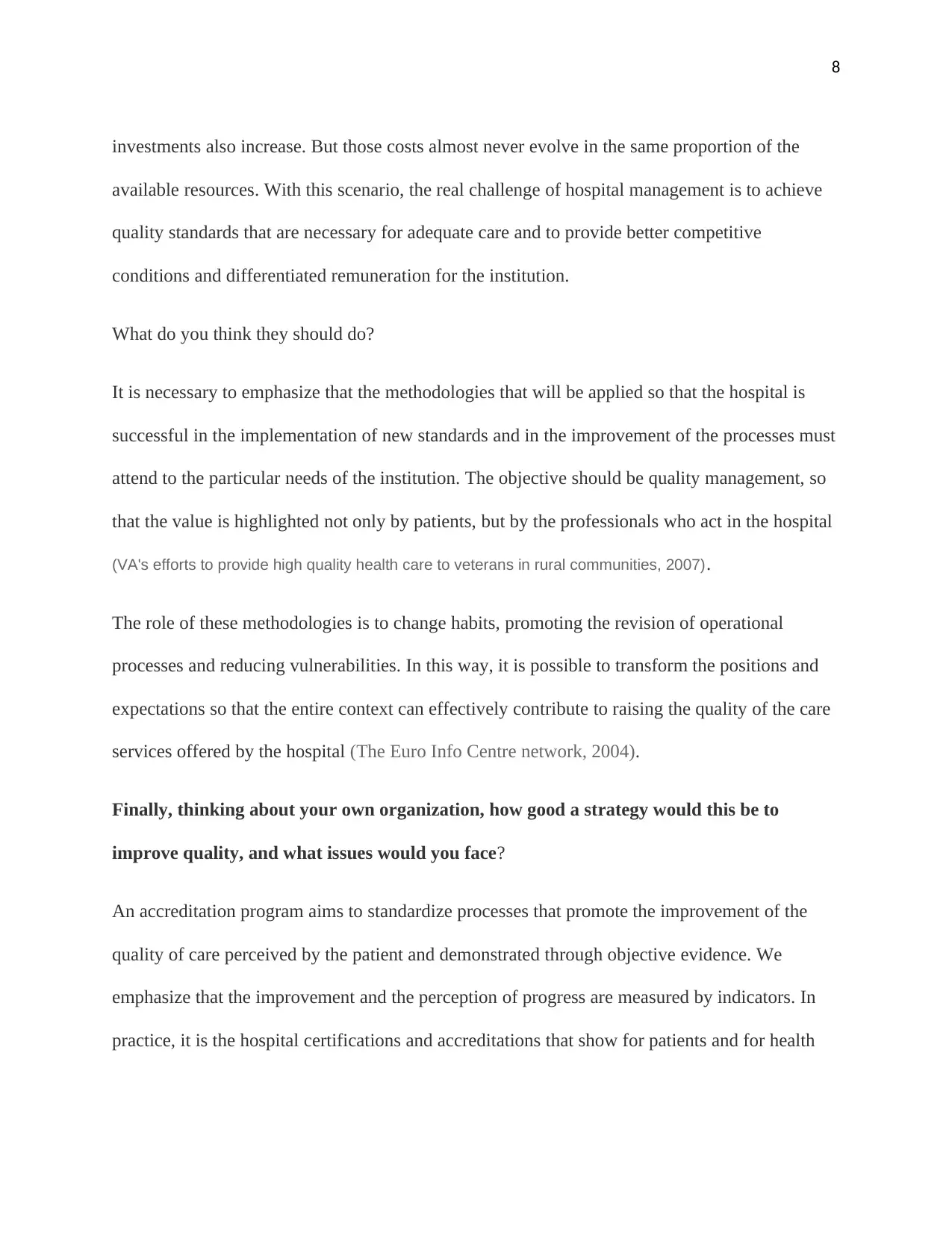
8
investments also increase. But those costs almost never evolve in the same proportion of the
available resources. With this scenario, the real challenge of hospital management is to achieve
quality standards that are necessary for adequate care and to provide better competitive
conditions and differentiated remuneration for the institution.
What do you think they should do?
It is necessary to emphasize that the methodologies that will be applied so that the hospital is
successful in the implementation of new standards and in the improvement of the processes must
attend to the particular needs of the institution. The objective should be quality management, so
that the value is highlighted not only by patients, but by the professionals who act in the hospital
(VA's efforts to provide high quality health care to veterans in rural communities, 2007).
The role of these methodologies is to change habits, promoting the revision of operational
processes and reducing vulnerabilities. In this way, it is possible to transform the positions and
expectations so that the entire context can effectively contribute to raising the quality of the care
services offered by the hospital (The Euro Info Centre network, 2004).
Finally, thinking about your own organization, how good a strategy would this be to
improve quality, and what issues would you face?
An accreditation program aims to standardize processes that promote the improvement of the
quality of care perceived by the patient and demonstrated through objective evidence. We
emphasize that the improvement and the perception of progress are measured by indicators. In
practice, it is the hospital certifications and accreditations that show for patients and for health
investments also increase. But those costs almost never evolve in the same proportion of the
available resources. With this scenario, the real challenge of hospital management is to achieve
quality standards that are necessary for adequate care and to provide better competitive
conditions and differentiated remuneration for the institution.
What do you think they should do?
It is necessary to emphasize that the methodologies that will be applied so that the hospital is
successful in the implementation of new standards and in the improvement of the processes must
attend to the particular needs of the institution. The objective should be quality management, so
that the value is highlighted not only by patients, but by the professionals who act in the hospital
(VA's efforts to provide high quality health care to veterans in rural communities, 2007).
The role of these methodologies is to change habits, promoting the revision of operational
processes and reducing vulnerabilities. In this way, it is possible to transform the positions and
expectations so that the entire context can effectively contribute to raising the quality of the care
services offered by the hospital (The Euro Info Centre network, 2004).
Finally, thinking about your own organization, how good a strategy would this be to
improve quality, and what issues would you face?
An accreditation program aims to standardize processes that promote the improvement of the
quality of care perceived by the patient and demonstrated through objective evidence. We
emphasize that the improvement and the perception of progress are measured by indicators. In
practice, it is the hospital certifications and accreditations that show for patients and for health
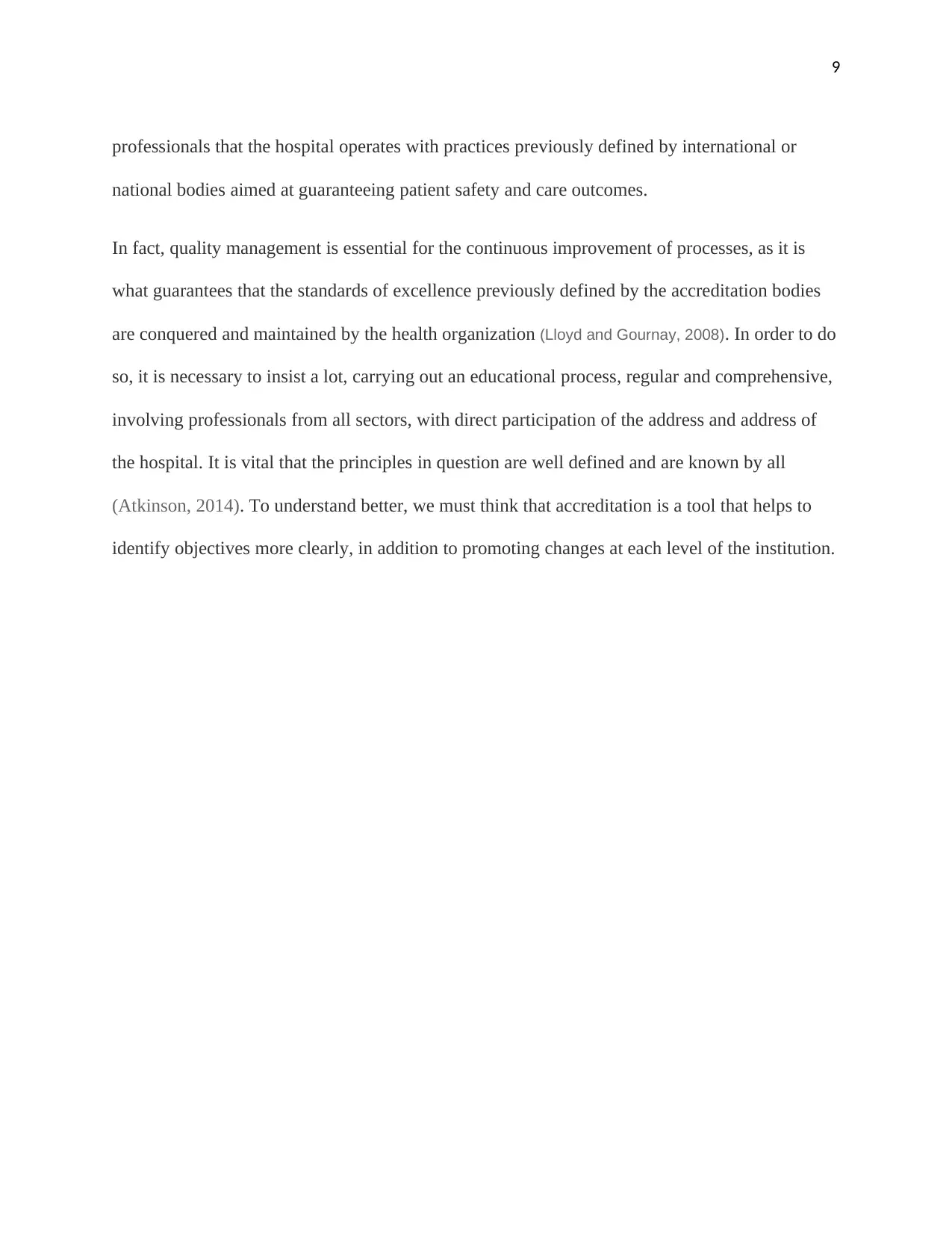
9
professionals that the hospital operates with practices previously defined by international or
national bodies aimed at guaranteeing patient safety and care outcomes.
In fact, quality management is essential for the continuous improvement of processes, as it is
what guarantees that the standards of excellence previously defined by the accreditation bodies
are conquered and maintained by the health organization (Lloyd and Gournay, 2008). In order to do
so, it is necessary to insist a lot, carrying out an educational process, regular and comprehensive,
involving professionals from all sectors, with direct participation of the address and address of
the hospital. It is vital that the principles in question are well defined and are known by all
(Atkinson, 2014). To understand better, we must think that accreditation is a tool that helps to
identify objectives more clearly, in addition to promoting changes at each level of the institution.
professionals that the hospital operates with practices previously defined by international or
national bodies aimed at guaranteeing patient safety and care outcomes.
In fact, quality management is essential for the continuous improvement of processes, as it is
what guarantees that the standards of excellence previously defined by the accreditation bodies
are conquered and maintained by the health organization (Lloyd and Gournay, 2008). In order to do
so, it is necessary to insist a lot, carrying out an educational process, regular and comprehensive,
involving professionals from all sectors, with direct participation of the address and address of
the hospital. It is vital that the principles in question are well defined and are known by all
(Atkinson, 2014). To understand better, we must think that accreditation is a tool that helps to
identify objectives more clearly, in addition to promoting changes at each level of the institution.
⊘ This is a preview!⊘
Do you want full access?
Subscribe today to unlock all pages.

Trusted by 1+ million students worldwide
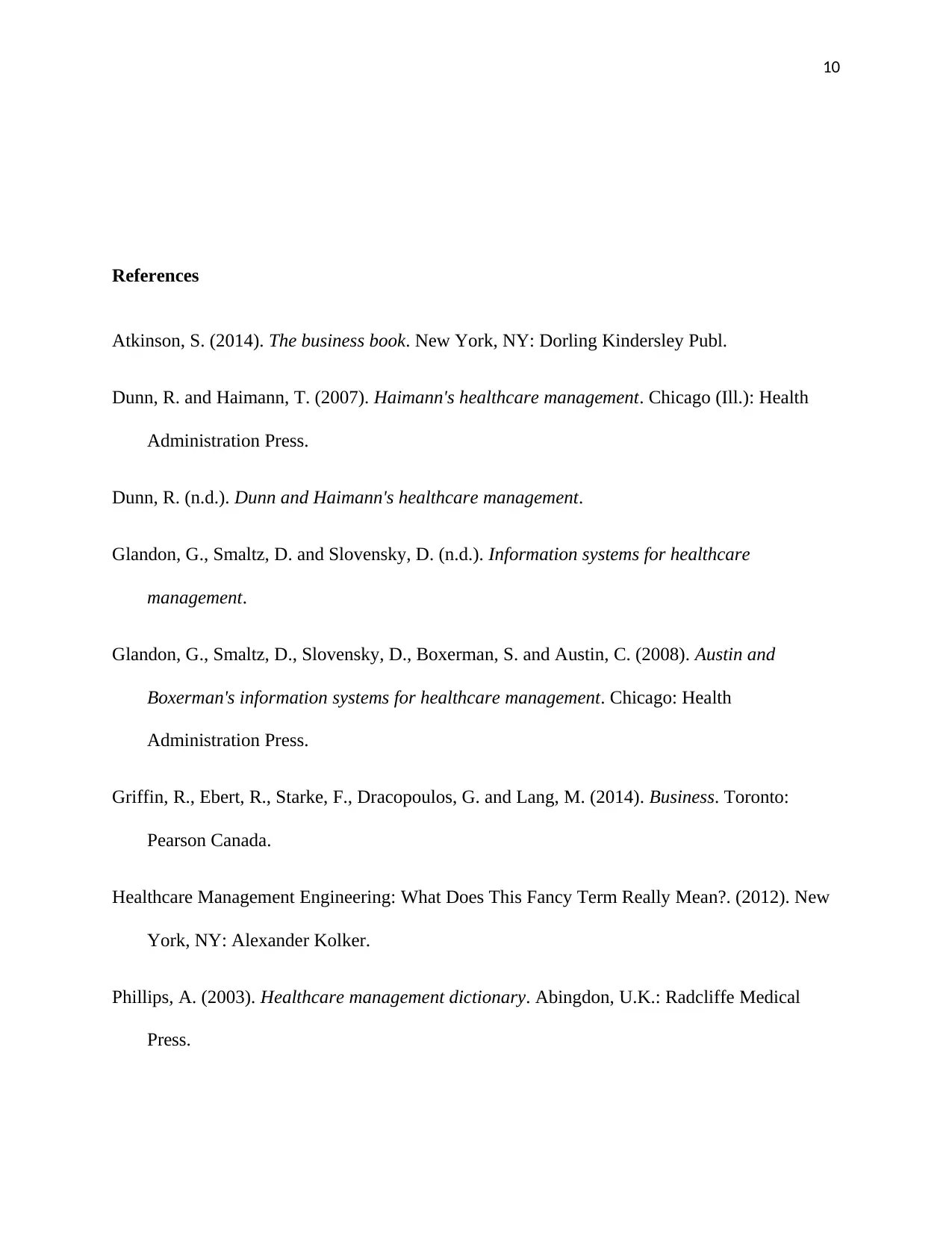
10
References
Atkinson, S. (2014). The business book. New York, NY: Dorling Kindersley Publ.
Dunn, R. and Haimann, T. (2007). Haimann's healthcare management. Chicago (Ill.): Health
Administration Press.
Dunn, R. (n.d.). Dunn and Haimann's healthcare management.
Glandon, G., Smaltz, D. and Slovensky, D. (n.d.). Information systems for healthcare
management.
Glandon, G., Smaltz, D., Slovensky, D., Boxerman, S. and Austin, C. (2008). Austin and
Boxerman's information systems for healthcare management. Chicago: Health
Administration Press.
Griffin, R., Ebert, R., Starke, F., Dracopoulos, G. and Lang, M. (2014). Business. Toronto:
Pearson Canada.
Healthcare Management Engineering: What Does This Fancy Term Really Mean?. (2012). New
York, NY: Alexander Kolker.
Phillips, A. (2003). Healthcare management dictionary. Abingdon, U.K.: Radcliffe Medical
Press.
References
Atkinson, S. (2014). The business book. New York, NY: Dorling Kindersley Publ.
Dunn, R. and Haimann, T. (2007). Haimann's healthcare management. Chicago (Ill.): Health
Administration Press.
Dunn, R. (n.d.). Dunn and Haimann's healthcare management.
Glandon, G., Smaltz, D. and Slovensky, D. (n.d.). Information systems for healthcare
management.
Glandon, G., Smaltz, D., Slovensky, D., Boxerman, S. and Austin, C. (2008). Austin and
Boxerman's information systems for healthcare management. Chicago: Health
Administration Press.
Griffin, R., Ebert, R., Starke, F., Dracopoulos, G. and Lang, M. (2014). Business. Toronto:
Pearson Canada.
Healthcare Management Engineering: What Does This Fancy Term Really Mean?. (2012). New
York, NY: Alexander Kolker.
Phillips, A. (2003). Healthcare management dictionary. Abingdon, U.K.: Radcliffe Medical
Press.
1 out of 10
Related Documents
Your All-in-One AI-Powered Toolkit for Academic Success.
+13062052269
info@desklib.com
Available 24*7 on WhatsApp / Email
![[object Object]](/_next/static/media/star-bottom.7253800d.svg)
Unlock your academic potential
Copyright © 2020–2025 A2Z Services. All Rights Reserved. Developed and managed by ZUCOL.



